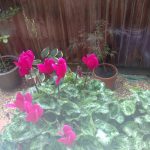I’ve been watching all of the posts on social media recently instructing us to prune this and prune that. You’d think if you didn’t prune something the world would end! Now, I hold my hands up to being guilty of contributing to this great prunathon with articles on the topic.
It is true, that one of the big mistakes us gardeners can make is to not prune shrubs and climbers at the correct time and in the wrong way, which can lead to preventing flowering the next year by cutting off the buds, poor shape, unsightly stumps, disease, a shrub outgrowing its space or becoming congested.
Pruning is always easy and straightforward but it is specific to each individual plant. We live in the age of smartphones however, so we can look up and read about the correct pruning for a plant before we do it. You’ll soon know how to prune your apples while trying never to prune a birch.
All of that said, as I’ve grown more experienced as a gardener, I’ve built the confidence to break away from the rules to explore my own way of gardening. At times I have not pruned something we’re meant to, either by forgetting or by deciding to see what would happen, and the results have been very useful to observe.
1) Don’t prune Clematis Group 3 for more height
Clematis have three pruning groups: 1, 2 and 3. Group 3 is pruned when dormant in winter close to the ground… except, what if you don’t?
Pruning is encourage to keep the flowering lower down, like a tall herbaceous perennial. Cutting near to the ground restarts the growing points in spring lower down, if left unpruned the growing points are higher up. The length of growth and flowering amount is the same but starts higher up if you don’t prune it.
I like to grow clematis and other climbers through shrubs and trees, so I often let our clematis scramble upwards and either prune it at head height, or do no pruning at all.
2) Don’t prune young shrubs
Most pruning guides for shrubs forget to say it’s often better not to prune them at all when they are still young and small. Young shrubs have thinner stems and bark, which can leave some vulnerable to very cold winters. In addition, if they are still small, they need to grow to the size that you want. A shrubby salvia for instance, is usually about 1m tall and wide or more, so for the first couple of years you may be better not pruning at all until it reaches that size. The same is true for very small lavender, rosemary, sage and many other shrubs that benefit from being left to grow strongly in the first few years.
3) Don’t prune hydrangea for bigger flowers
Are bigger flowers always better? Sometimes they are, sometimes they’re not. You might prefer to have lots of smaller flowers, rather than fewer big and blowsy ones. Hydrangea don’t actually need pruning at all, though you might want to snip off the dead flowers in spring. I would only prune a Hydrangea if I wanted to contain its size, or to remove damaged stems.
4) Don’t prune for shape
I read an article the other day encouraging readers to prune shrubs for a nice symmetrical dome. My thought was ‘no thanks’. It’s great if people do want formal symmetry and rounded blobs in their gardens but for anyone riding high on the natural look trend, the wild way is to encourage natural asymmetrical and random shapes. There is a lavender in our herb bed that is really misshapen, one branch is higher than another lower branch. It’s as far away from a traditional symmetrical blob lavender as you can get but to my eyes it’s far more beautiful because of it. Plants don’t always grow in domes in the wild and we can embrace that.
5) Don’t prune wisteria
Wisteria has a twice yearly prune recommended for flowering, but what happens if you don’t? I’m growing a wisteria up a tree in our garden and have no intention of climbing up after it to prune it. It may flower slightly less, but it will still flower as it would in the wild.
The aim of this article is not to stop you from pruning things, but to explore what happens if you don’t. To study climbers, shrubs and trees to understand if there are other ways of growing them. If you want to that is…
Are there other plants and scenarios where you’ve decided not to prune something? Please share what you’ve found in the comments below.
Join my weekly Wild Way newsletter



